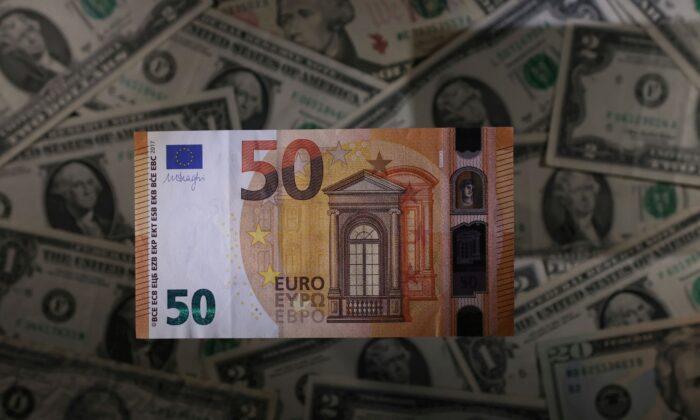LONDON—The euro weakened on Tuesday after European Central Bank President Christine Lagarde tried to rein in interest rate hike expectations that lifted the currency to a three week-high last week.
The ECB’s hawkish twist last week took markets by surprise and sent yields on peripheral eurozone debt surging as investors worried about the impact of faster-than-expected monetary tightening on the bonds of the most indebted countries.
But on Monday, Lagarde struck a more cautious tone, saying high inflation is unlikely to get entrenched and ECB council member Pablo Hernandez de Cos on Tuesday said any central bank move “has to be gradual.”
Eurozone bond yields edged lower on Tuesday but many in the currency market were still concerned that a sharp rise in bond yields could weigh on the prospects of a broad-based economic recovery.
Those concerns were particularly acute for peripheral economies such as Italy whose 10-year bond yields have surged to their highest levels since May 2020 while inflation-adjusted yields are just a shade from popping into positive territory, having risen 50 bps since the ECB policy decision.
On Tuesday, the euro was down 0.1 percent, struggling to hold above the $1.14 levels. It rose to a high of $1.1483 on Friday, its highest level since Jan. 14.
“Can the euro go higher if periphery spreads blow out and if Italian 10-year real yields turn positive, can the economy cope with that,” said Kenneth Broux, a strategist at Societe Generale in London. “That is the million dollar question investors are asking.”
Investors were also looking carefully at the future trajectory of interest rates between the United States and Europe.
“After all, investors are well aware that, once the ECB ’shock' has been absorbed, policy rates are set to climb much more in the US than in the eurozone over the coming months,” Unicredit strategists said in a daily note.
While money markets were pricing in as much as 134 bps in cumulative rate hikes from the U.S. Federal Reserve over the remainder of 2022, analysts were expecting 50 bps in hikes from the ECB over that period.
Still, the short-term outlook has tilted in favor of the single currency, with the widely watched bond yield spread between U.S. and German 10-year debt narrowing in late January to around 170 bps from an April high of 194 bps.
The U.S. dollar index rose 0.1 percent to 95.51.
On Monday, bitcoin and the Australian dollar had posted gains as equity markets rallied in Europe, but the latter was a bit softer on Tuesday as a cautious mood prevailed in Asia. The Aussie was broadly flat at $0.7120.
Bitcoin punched through its 50-day average to top $44,000 for the first time in nearly a month on Monday and held there in Asia for a gain of more than 17 percent in four sessions.






Friends Read Free